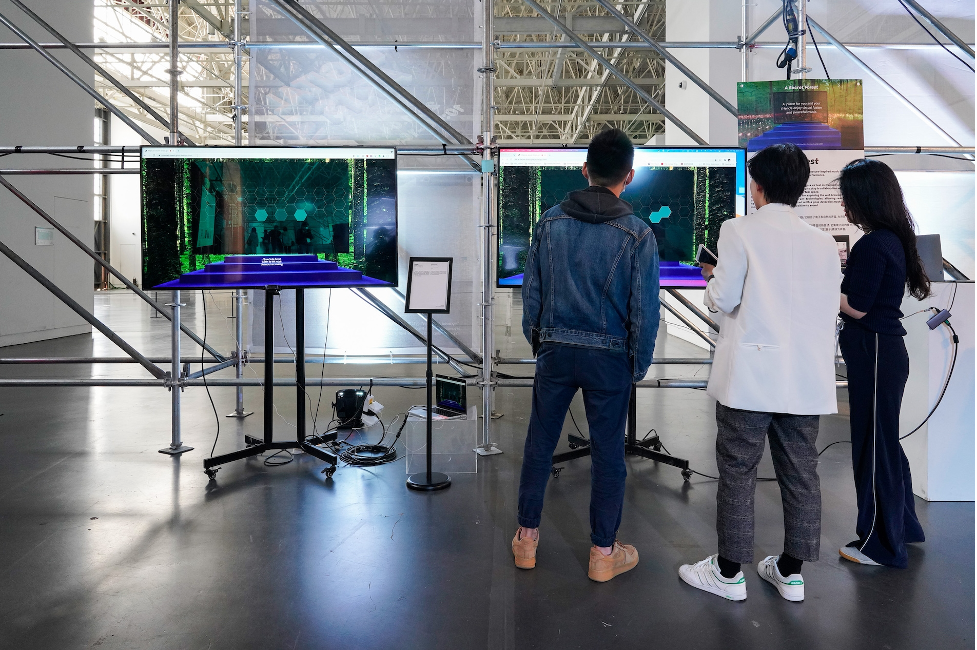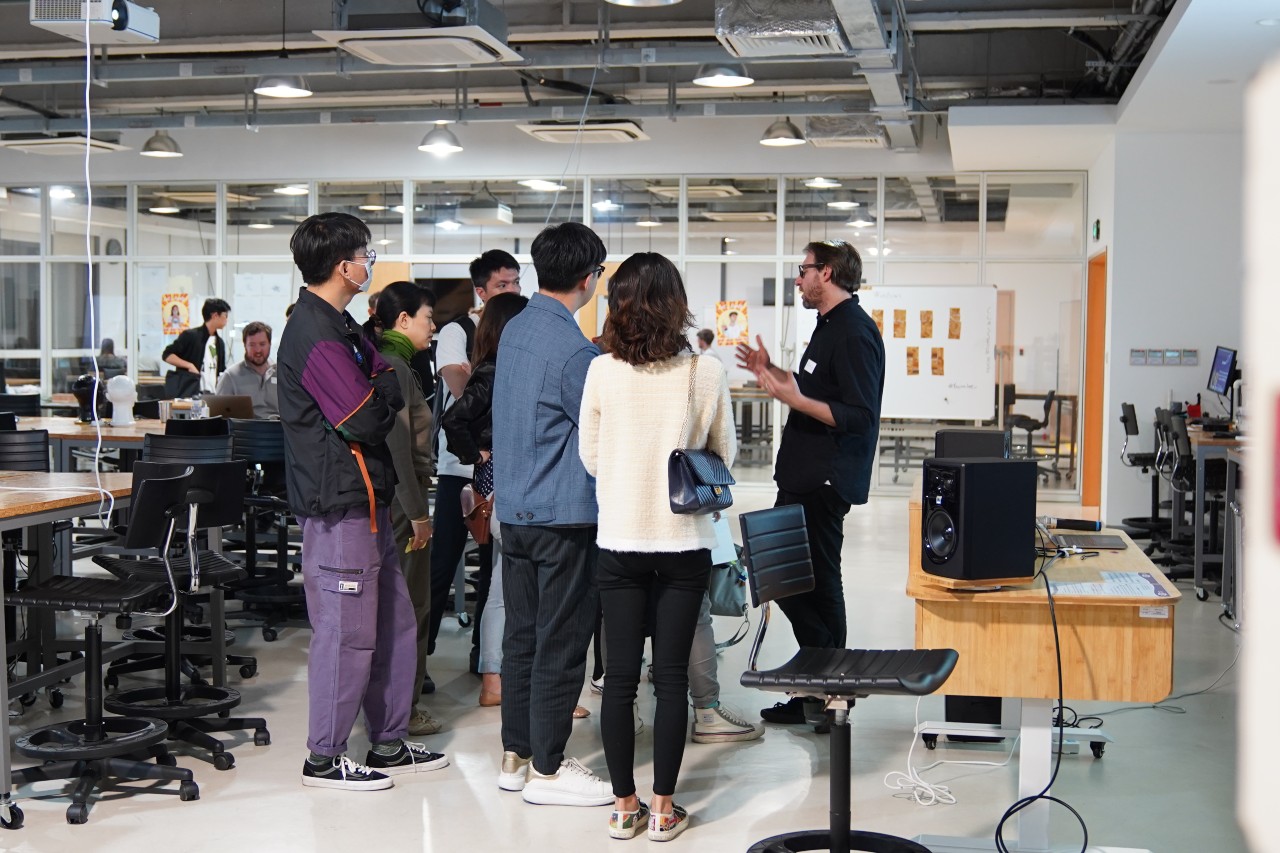Global Low Residency MA degree in Interactive Media Arts stems from a collaboration between the Interactive Telecommunications Program (ITP) at Tisch School of the Arts at NYU and the Interactive Media Arts Program (IMA) at NYU Shanghai. The year-long degree involves 3 site-specific sessions at NYU New York (Summer), NYU Berlin (January), and NYU Shanghai (Summer) interspersed with 2 online semesters in the Fall and Spring. A curricular emphasis on context and connectivity along with a spirit of experimentation, collaboration and community will be infused across the entire experience. By traversing a series of locations and environments, both physical and digital, the program is designed to provide students with an active understanding of the current global landscape of computational media and technology.
Prof. Craig Protzel is the Director of the Master of Arts program in Interactive Media Arts (IMA). He holds a Master's degree from the Interactive Telecommunications Program (ITP) at NYU Tisch School of the Arts and a Bachelor's degree in Human Biology from Stanford University. Recently, the Office of Graduate and Advanced Education had an interview with him, where he answered questions about his personal experience, the components and goals of the IMA program, potential career paths after graduating the program, how the program relates to trending topics like the “metaverse”, and the “creative portfolio” required in the admissions process.
About the Program Director:
Why did you choose an interactive-media-related program at NYU for your graduate education?
Before I chose ITP at NYU, which is a sister program of our Interactive Media Arts Program (IMA), I had spent many years in the entertainment industry until I reached a point where I was thinking about moving on to other things. I was really intrigued by the emergence of the smartphone and more powerful computers, with which I wanted to better understand how they could work. Storytelling had been my longtime passion and fusing tech into storytelling was something I wanted to explore more. So, I started to look into graduate schools and I knew that NYU had a strong reputation when it came to tech and art.
I went on a campus tour organized by the program, curious but not yet committed, and I ended up falling in love with it. I liked the fact that the Interactive Telecommunication Program was receptive to people from different backgrounds and experience levels. The main criteria were interest, passion and a desire to learn, experiment and create. I intuitively wanted to be in this environment.
At Stanford, I studied Human Biology, where the focus was on making sense of the human experience. I think, to a large extent, the ITP and IMA share that focus. Different methods and technologies may be involved but ultimately the work produced is meant to be used by people. The core is the human experience. In this way, ITP aligned with my interest and undergraduate education.

IMA Low Res Program students show works at Shanghai Yuz Museum
About the IMA Program:
As the director of the MA in Interactive Media Arts (IMA) program, how would you define and describe the program in plain words?
I believe the name “Interactive Media Arts” gives people a general idea of what the program covers. To put it in other terms, I often describe the program as a mixture of art, tech and design.
To break it down even more, I think of art as creating things that other people can engage with, such as works and projects. A big part of the program is about making projects. Tech is also heavily featured and by tech I refer to computation, for example, coding. Technical tools and skills are crucial in project creation and problem-solving. If computation provides the necessary technical support, design is about the strategy and concrete steps you need to solve a problem. There are a lot of problems you may encounter. Are you trying to allow for a particular action to occur? Are you trying to create a system where people can have a lively conversation with your work? Interactivity is a core part of our projects, which we often characterize as a dialogue between the projects and the audience who experience them. The design part of the program helps our students develop competence in enabling that interactivity.
On a higher level, thinking beyond the specific components, what is the IMA program really about? I’d like to say that the goal of the program is to give people the ability to express themselves creatively. This program will inspire you to find the answers to many important questions. How do you engage and think critically with the digital tools and tech that have infused our world? How do you make sense of them when you are using them? Can you look inside the black box and try to understand a little bit more about what's going on so that you can be an active participant and have a dialogue with the persons and organizations that are very much shaping our world?
What are some potential career choices for IMA graduates?
Overall, when you go through this program, you gain experience with a variety of tools that will empower you to pursue many paths. To be more specific, in terms of the industries, I think the program definitely prepares people for jobs in tech, media and communications, and design. With regard to titles, many suitable jobs usually have a title with the word “designer” in it: user experience designer, interaction designer, product designer. But you can also be a project manager, a creative director, or a technical director. The program positions you well to understand and communicate with different people because you become what's often characterized as “T shaped”, meaning you not only have depth in art, tech and design but also breadth in your knowledge across a variety of fields.
In addition, if you have an entrepreneurial spirit, I think this program is also very well suited because it tends to push outside of traditional boundaries. If you want to be an entrepreneur or work for a startup, you need to be willing to explore spaces where there are more unknowns.
How do you think the IMA program is related to trending fields and topics, for instance, “metaverse”?
Metaverse has been everywhere recently. So, does the program touch upon this trending term? The answer is “Yes” and we have actually been addressing this topic for quite some time, even before the term became so popular.
Every course that we offer expects you to make some projects, so as you traverse the program you build up a portfolio which is representative of what you did and what you're capable of doing and can be fairly valuable in your job hunting. Almost every class has some experiential, storytelling and visual component. When it comes to the metaverse, whether you think of it as virtual worlds operating within virtual spaces, an identity or a terrain, all of our courses touch upon these areas. We offer a class that's called Virtual Worlds, which focuses on 3D world-building. It’s so relevant to the metaverse that we can probably rename the course to “Metaversing'' if we want. We also ran a class called Worlding. Besides three-dimensional visuals, world-building includes developing a narrative, history, culture, lexicon, characters and values for a constructed space. What is this world? Who is in this world? What happens in this world? What do you care about in this world? Our classes ask and answer those questions which are central to the thinking and systems of the Metaverse.
The Metaverse is not the only area of emerging media that our program covers. We offer classes that dive into topics like AI and Web 3.0 addressing questions like “What does it mean to have decentralized distributed models of sharing and cooperation?”. Additionally, there are courses that are about connected multi-person real-time experiences, offering insights on how softwares such as Zoom work, and how we can build our own Zoom-like platform.

Prof. Craig Protzel answering questions from students
About the Admission:
During the application process, many applicants are interested in learning more about what kind of creative portfolio the program would prefer. How would you define “creative portfolio” in the admissions requirements of the IMA program? How sophisticated does the “portfolio” need to be?
Traditionally, when graduate applications expect creative portfolios oftentimes they want to see a demonstration of your skills or expertise in that particular field. However, we're not expecting anyone to have expertise in what we do. What we are hoping to see is that you've attempted to make projects in whatever area, be it poetry, painting, or dance. For example, an applicant may say “I achieved these at a hackathon in two days!” Another applicant might have worked on a short film for a year. Both are great. Share with us whatever you have made, tell us how you were involved, what role you played in the project and whether it was part of your hobby or a task assigned to you, etc.
Through the creative portfolio, we would like to better understand who you are, what you care about, what you're interested in, and how you express yourself. Also, we are curious about why you want to be part of this program, what it is about this program that's interesting to you, what you are bringing to the community, and what you hope to get out of it.
All in all, the creative portfolio is not meant to discourage anyone from applying. It is really an opportunity for applicants to tell us their story and better share with us who they are.


